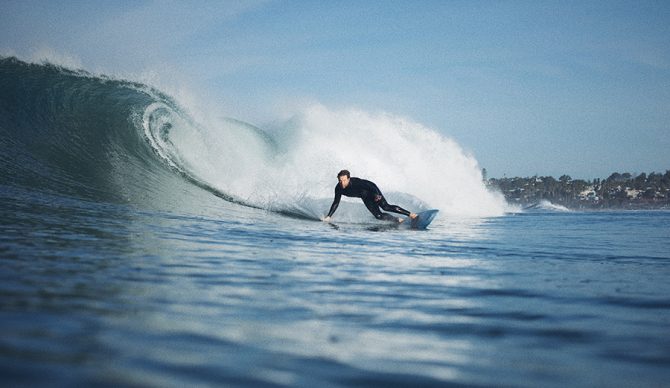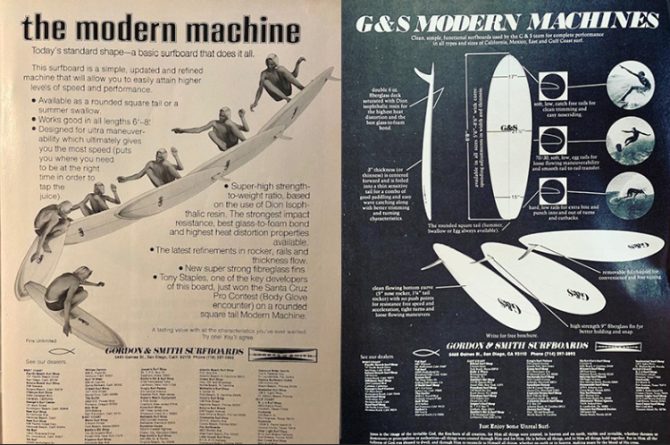Mr. February, a mid-length, and the highline. Photo: Screenshot

Editor’s Note: Welcome to our new series, “By Design” with Sam George that examines the genius, and sometimes the mystery, of surfing’s storied design history. Sam has been writing about surfing for more than three decades and is the former Editor-in-Chief of SURFER magazine. He won an Emmy for his work on the 30 for 30 documentary, Hawaiian: The Legend of Eddie Aikau. Today, Sam looks at the mid-length surfboard.
Something is definitely afoot in the world of surfboard design these days — and in some cases, a foot and a half. More and more surfboard manufacturers, even many of those previously known for aggressively championing conventional “high performance” designs, are offering equally refined models that are longer, wider and with sophisticated foil and outline contours, the objective being to provide surfers with more functional performance options. Categorized under the genre “mid-length”, these boards are being marketed and embraced in a manner inconceivable just a few years earlier, when anything deviating from designs currently ridden by sponsored pro surfers were relegated to the “fun board” heap, seen more as a concession to waning skills and devotion than as a tool for “serious” surfing.
This mindset appears to be changing, and the board companies adding mid-lengths to their lines have the numbers to prove it. A recent video of style-master Torren Martyn, riding his Simon Jones-shaped twin-fin mid-lengths, racked up over 800,000 views, while another from Channel Islands Surfboards featuring longtime mid-length proponent Devon Howard drew more than 300,000 obviously very interested viewers. Compare these numbers to a compilation of 2022 WCT highlights from the tour’s highest-ranked Australian pro, the views topping out at around 22,000.
This attention gap clearly indicates a significant paradigm shift in the surfboard market. In a media environment filled almost exclusively with imagery of pumping Superbank and Desert Point, epic Mexican and New Jersey hurricane swells, 40-foot Aussie slab barrels and Texas wave-pool aerials, the idea of designing and marketing a surfboard sensibly designed for the majority of waves encountered on a daily basis by the majority of surfers might not only be seen as a bit risky, but actually disruptive.
Yet this anti-trend is hardly new. The history of the mid-length and its accompanying aesthetic goes back much further than the current incarnations being endorsed by highly skilled surfers like Martyn, Howard, or even iconoclast Joel Tudor, who’s been riding variations of the design for years. For this we go all the way back to the year 1974, and the introduction of Gordon and Smith Surfboard’s “Modern Machine.”

Mr. Howard, and that beautiful, signature bottom turn. Photo: Michael Townsend
“The Modern Machine was meant to be a sensible alternative to the narrow, Hawaiian-style boards that filled the surf magazines and surf movies at the time,” says Eric Gordon, son of the late Larry Gordon, whose company G&S was one of the sport’s most innovative throughout the 1960s and ‘70s. “Even though (head G&S shaper/designer) Skip Frye had been working with the egg shape and the super-short fish since ’71, by ’74 all anyone seemed to be offering were the sort of 6’10” winged pintails you’d see being ridden on the North Shore.”
If this state of affairs sounds a bit familiar, then so might the company founder’s solution to what he viewed as a serious disconnect between how surfing was being presented and how it was actually being experienced by most surfers.
“My dad was big believer in the idea that you should ride a board designed for the way you surf, in the waves you surf,” recalls Gordon. “In that way the Modern Machine was a radical design, bringing surfers back to a more rational option that actually worked.”

The Modern Machine ads from SURFER magazine.
The design, the product of much focused R&D by Frye and top team rider Tony Staples, was decidedly different than anything seen in the period magazine ads. With its wider outline, lower entry rocker, foiled rail profile and rounded squash-tail, the Modern Machine stood out among the plethora of pointy semi-guns on offer, yet it was never meant to accommodate less significant involvement.
“It was actually designed as a high performance surfboard,” says Gordon. “In 1975 Tony Staples won an international pro contest up in Santa Cruz, riding a Modern Machine in six to eight-foot surf, competing against guys like Shaun Tomson on their pintails. So it was high performance, but still meant to work in the conditions you’d surf 80 percent of the time.”
Riding this wave of sensible performance characteristics, G&S went all in on the Modern Machine.
“For two solid years it was all we advertised,” remembers Gordon. “And we sold tons of them right up until 1978, when the MR twin fin started getting popular. In fact, we were the first U.S. surf company to market that model, too.”
Naturally, Eric Gordon and his G&S team currently offers its customers a modern version of Modern Machine, while at the same time giving credit to another surfboard company for helping to provide renewed impetus in the movement to mid-lengths.
“We certainly didn’t invent anything new,” asserts Channel Islands Surfboards’ Devon Howard. “But basically just took what was essentially an egg design and did an Al Merrick treatment to the bottom and rocker, adding things like subtly rolled entry and vee. Previously there has always been a “fun board” stigma attached to boards like this. But coming from Channel Islands, with its reputation in the “high performance” surfboard market, it kind of gave surfers permission to ride one. Even though I already knew that this is what so many surfers should be riding.”
It appears that more and more surfers are coming around to this way of thinking, as evidenced not only by the robust sales of the “CI Mid”, but by response to videos featuring performers like Howard, Michael February and Clif Kapono.
“The videos, especially the ones we shot at Malibu, really grabbed people,” says Howard, who was shown riding his mid-length in clean, three-foot point surf. “Apparently a lot of surfers saw that and thought to themselves, ‘That’s what I want to be doing on a wave, what I want to be feeling.’ Which is obviously one of the reasons we’ve sold so many of them.”
Eric Gordon sees the popularity of these new modern machines as validation of his father’s intent when introducing G&S’ original model 47 years ago.
“Today, just like back then, the proof is in the performance,” says Gordon. “My dad was really behind this design, and would have loved to see a new generation of surfers choosing to ride it.”
Be sure to visit The Inertia website to view valuable Surfing related News and Resourceful Articles regularly.
Speaking of helpful articles from the good people behind The Inertia, you may want to click on the following link to learn about how BRA Supporting Vendor Partner SurfCare can help you generate additional revenue from Surfboard Sales without increasing inventory: https://boardretailers.org/you-might-not-need-to-worry-about-breaking-a-brand-new-surfboard-ever-again-via-the-inertia/
If you are not yet a BRA Retail Member, you can easily opt in to either Regular (no cost) or Distinguished ($100/yr.) Membership via this super simple join form

